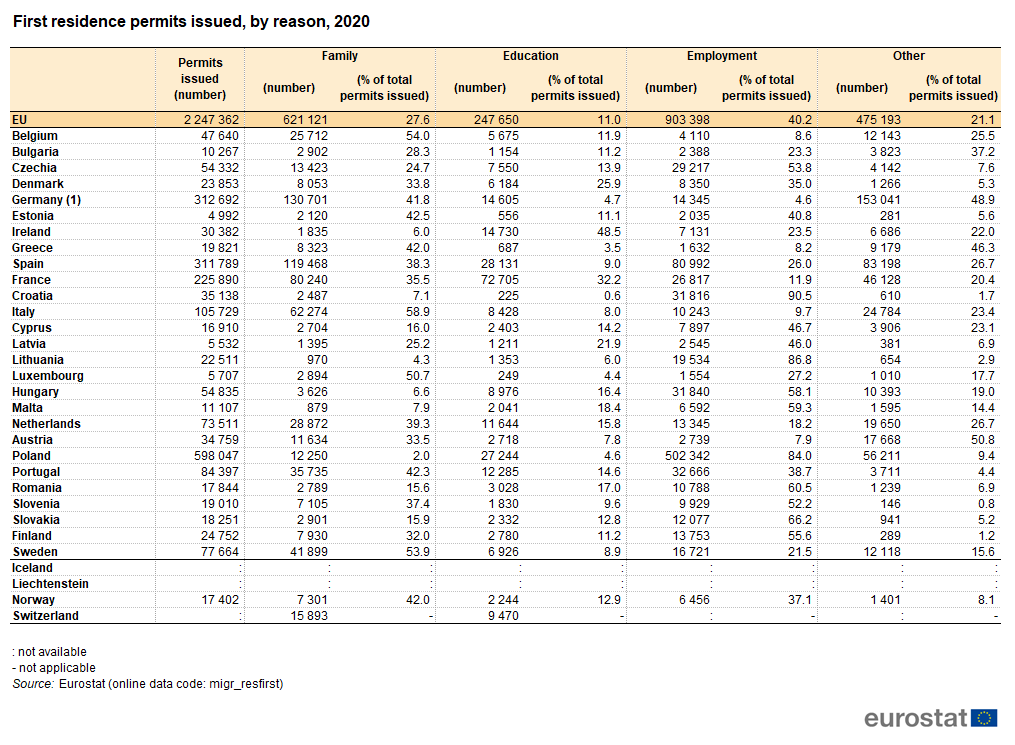Poland has issued more first residence permits to immigrants from outside the European Union than any other member state for the fourth year in a row. Meanwhile, the country has also received its highest number of asylum applications in five years, amid a surge in refugees from Afghanistan and Belarus.
The new data confirm other indicators showing that a recent wave of mass migration to Poland – unprecedented in the country’s history and among the largest anywhere in Europe – is continuing through the pandemic.

In 2020, Poland issued just under 600,000 first residence permits to people from outside the EU, according to figures from Eurostat. That was almost double the number issued by Germany (312,692) and Spain (311,789), which were in second and third place.
In proportion to population, only the small Mediterranean island states of Malta and Cyprus issued more permits than Poland.
As in previous years, by far the largest proportion of residence permits granted in Poland went to Ukrainians (82%). The next biggest groups were also from former Soviet states – Belarus (8.5%), Russia (2%) and Georgia (0.8%) – followed by Turkey (0.8%).

Poland also continued to grant a far higher proportion of permits for employment reasons (84%) than western countries such as Germany (4.6%), Spain (26%) and France (11.9%), and relatively few for family, education and other reasons.
In most countries, the number of permits issued fell last year compared to 2019, likely as a result of the pandemic. In Poland, the figure dropped from 724,416 in 2019 to 598,047 in 2020. Across the EU as a whole, first residence permits were down by around 24% in 2020.
However, Polish data from this year indicate that immigration has picked up again, with the number of registered foreign workers growing 35% in the year to June 2021.
Meanwhile, Poland’s Office for Foreigners (UdSC) has revealed that a higher than normal number of applications for international protection have been submitted in the country so far this year.
In the first three quarters of 2021, almost 5,200 foreigners claimed asylum. That was more than in the whole of 2020 (2,800), 2019 (4,100), 2018 (4,100), 2017 (3,500), and 2015 (5,000).
It is lower than the full-year figure for 2016 (12,000), when there were a large number of applications by Chechens. This year’s data, however, only reach the end of September, since when there has been a continued surge in border crossings from Belarus, including by people claiming asylum.
📊 Od lipca zauważalny jest wyraźny wzrost liczby składanych wniosków o udzielenie ochrony międzynarodowej w Polsce. W pierwszych trzech kwartałach br. złożyło je prawie 5,2 tys. cudzoziemców – głównie obywatele Afganistanu i Białorusi.
➡️ https://t.co/BKpz8opckC#cudzoziemcy pic.twitter.com/mLd7p7sl6L— Urząd do Spraw Cudzoziemców (@UdSC_gov_pl) October 11, 2021
Among those who have applied for protection so far this year, the largest proportion (32%) are from Afghanistan, followed by Belarus (27%) and Russia (16%). The latter figure includes Chechens.
After Kabul fell to the Taliban in August, Poland evacuated over 1,000 Afghans who had worked with Polish and other NATO forces, as well as their families. They then applied for asylum in Poland, with the first 60 applications being approved last week.
The Polish authorities have also sought to support Belarusians threatened by the clampdown following last year’s disputed re-election of President Alexander Lukashenko. Thousands of Belarusians have fled to Poland, with many claiming asylum.
Main image credit: Jakub Orzechowski / Agencja Gazeta

Daniel Tilles is editor-in-chief of Notes from Poland. He has written on Polish affairs for a wide range of publications, including Foreign Policy, POLITICO Europe, EUobserver and Dziennik Gazeta Prawna.




















